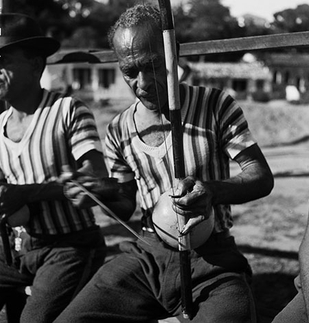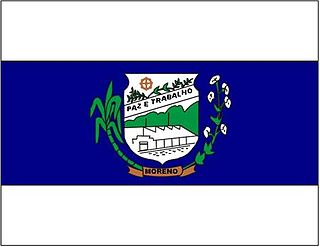This article needs additional citations for verification .(January 2024) |
Nascimento Grande was a capoeira fighter from 19th century Recife. He disappeared from public life in the early nineteen hundreds. [1]
This article needs additional citations for verification .(January 2024) |
Nascimento Grande was a capoeira fighter from 19th century Recife. He disappeared from public life in the early nineteen hundreds. [1]

Camaragibe is a city in the Northeastern region of Brazil, in the state of Pernambuco. It lies within the Greater Recife — Brazil's 5th-largest metropolitan area.

The berimbau is a traditional Angolan musical bow that is commonly used in Brazil. It is also known as sekitulege among the Baganda and Busoga.

In Brazil, public holidays may be legislated at the federal, statewide and municipal levels. Most holidays are observed nationwide.

Manuel dos Reis Machado, commonly called Mestre Bimba, was a Brazilian capoeira mestre and the founder of the capoeira regional style. Bimba was one of the best capoeiristas of his time, undefeated in numerous public challenges against fighters from various martial arts.

João Pereira dos Santos, known as Mestre João Pequeno was capoeira Angola mestre and one of the principal students of mestre Pastinha.

Vicente Ferreira Pastinha, known as Mestre Pastinha, was a mestre of the Afro-Brazilian martial art capoeira and a codifier of the traditional capoeira Angola style.

João Oliveira dos Santos, better known as Mestre João Grande, is a Grão-Mestre of the Afro-Brazilian martial art of capoeira angola who has contributed to the spread of this art throughout the world. He was a student of the "father of Angola", Mestre Pastinha, and has an academy in New York City.

Frevo is a dance and musical style originating from Recife, Pernambuco, Brazil, traditionally associated with Brazilian Carnival. The word frevo is said to come from frever, a variant of the Portuguese word ferver. It is said that the sound of the frevo will make listeners and dancers feel as if they are boiling on the ground. The word frevo is used for both the frevo music and the frevo dance.
Alessandro Nunes Nascimento or simply Alessandro is a Brazilian former football striker.
Marcos "Barrão" DaSilva is a Brazilian capoeira mestre (master) and founder of Grupo Axé Capoeira, which has schools worldwide. He began Grupo Axé officially in 1982 in Vancouver and since has had schools established around the world.

Roberto Antonio Rojas Saavedra, nicknamed El Cóndor, is a retired Chilean football goalkeeper. In 1989, he deliberately injured himself during a World Cup qualifying match in an attempt to avoid a loss by the Chile national team. The incident resulted in a lifetime ban for Rojas and one World Cup ban for Chile. His ban was subsequently lifted in 2001.

São Lourenço da Mata is a city located in the greater Recife metropolitan area in the state of Pernambuco, with a population of 114,079 inhabitants. The city was one of the hosts of the 2014 FIFA World Cup. The new Arena Pernambuco is set to boost the local economy with the construction of a new stadium, flats, car parks, hospital, technical school, shopping center, integrated metro-bus station, and road improvements.

Maurício dos Santos Nascimento, known simply as Maurício, is a Brazilian footballer who plays as a centre-back for Chapecoense.

Recife Metropolitan Area, officially the Metropolitan Region of Recife, is a major metropolitan area in Northeast Brazil with a population of 3,7 million as of 2022, centered on the state capital of Recife, Pernambuco. In 2017, it was ranked as the 8th largest metropolitan region nationally.

Moreno is a city in the state of Pernambuco, Brazil. It's integrated in the Recife metropolitan area with another 13 cities. Moreno has a total area of 195.6 square kilometers and had an estimated population of 63,294 inhabitants in 2020 according with IBGE.
Venturosa is a city in northeastern Brazil, in the State of Pernambuco. It lies in the mesoregion of Agreste of Pernambuco and has 338.12 sq/km of total area.

Jucati is a city located in the state of Pernambuco, Brazil. Located at 217 km away from Recife, capital of the state of Pernambuco. Has an estimated population of 11,485 inhabitants.

Capoeiras (Scrubs) is a city located in the state of Pernambuco, Brazil. Located at 252.7 km away from Recife, capital of the state of Pernambuco. Has an estimated population of 20,048 inhabitants.

Events in the year 1892 in Brazil.
The 2017 Copa do Nordeste was the 14th edition of the main football tournament featuring teams from the Brazilian Northeast Region. The competition featured 20 clubs, with Bahia and Pernambuco having three seeds each, and Ceará, Rio Grande do Norte, Sergipe, Alagoas, Paraíba, Maranhão and Piauí with two seeds each.